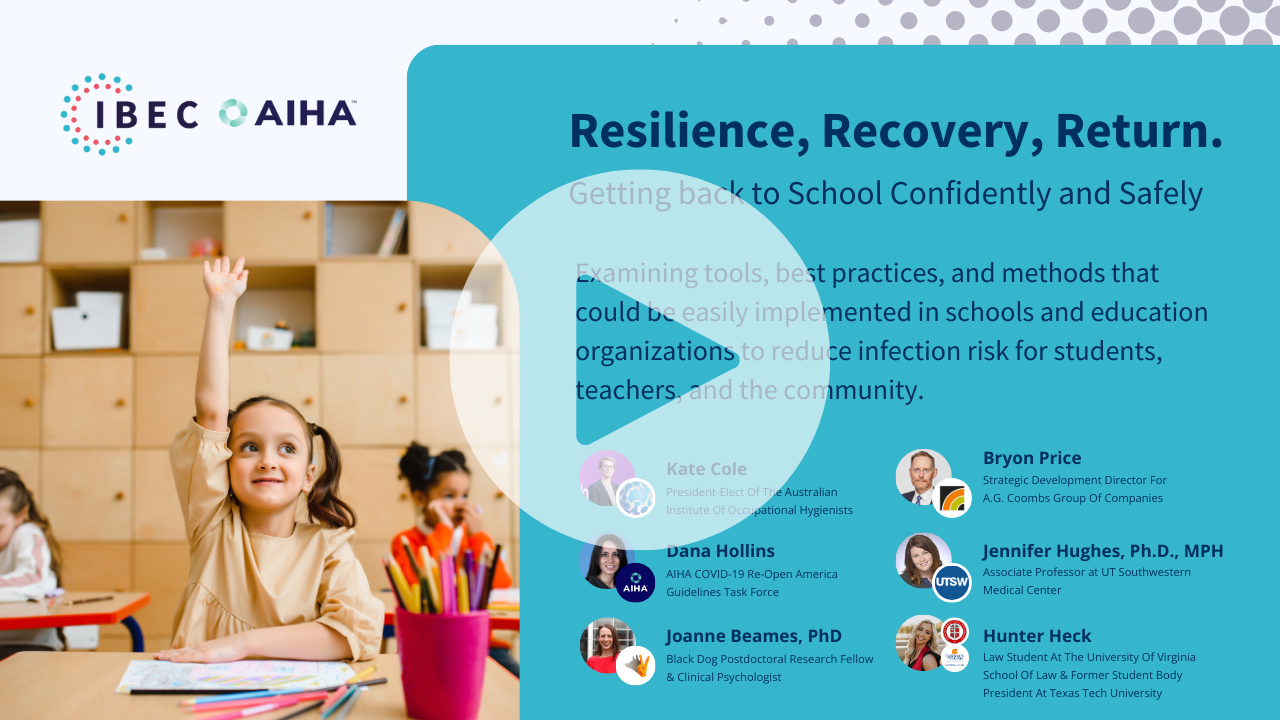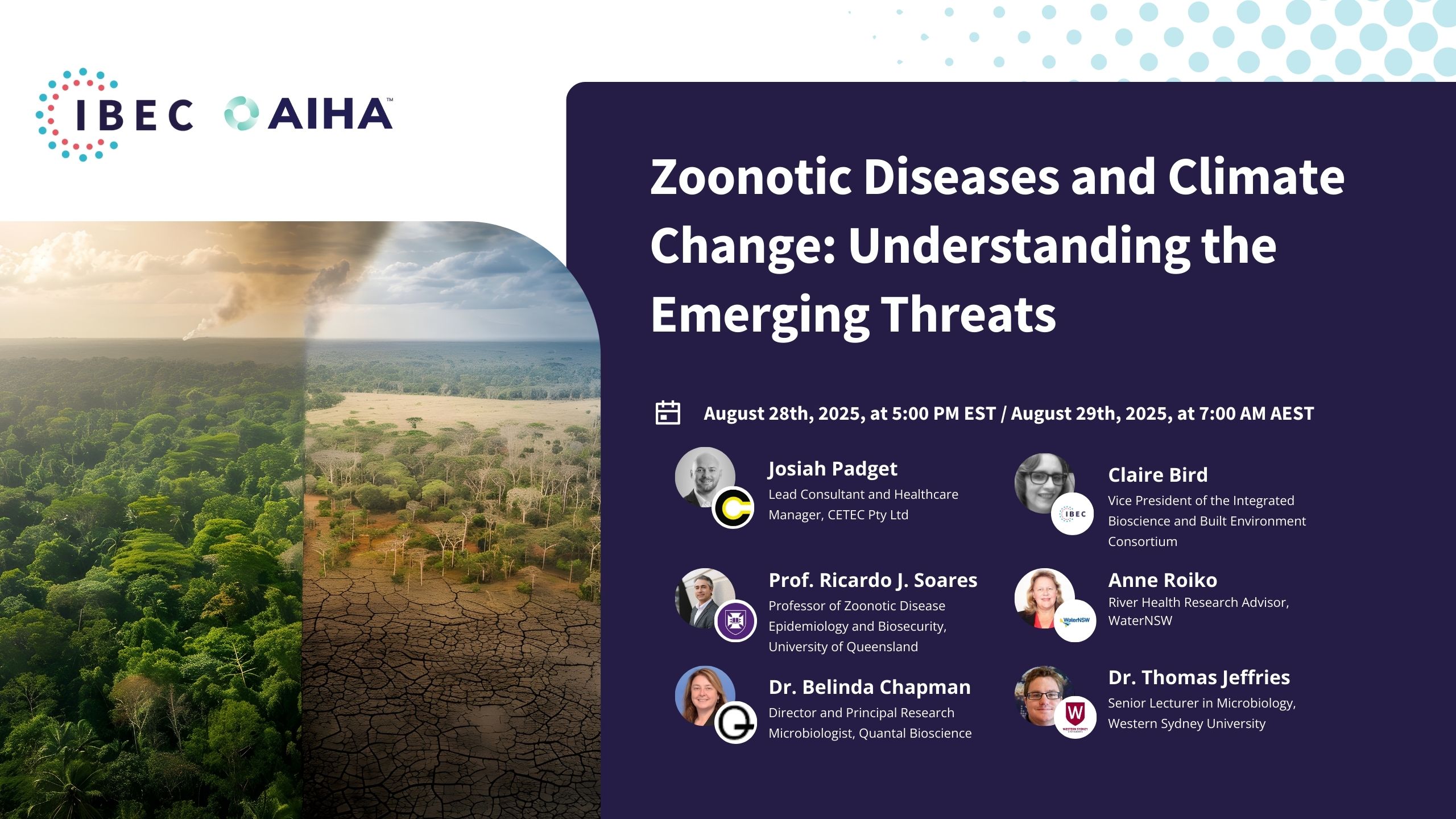Watch this session to learn about opportunities to translate science and knowledge from infection control and biosecurity communities to reduce exposure and better manage risk while going back to school
CLEAN Lessons Learned
Resilience, Recovery, Return. Getting back to School Confidently and Safely
This session focused on opportunities to translate science and knowledge from infection control and biosecurity communities to reduce exposure and better manage risk while returning to school.
We examined tools, best practices, and methods that could be easily implemented in schools and education organizations to reduce infection risk for students, teachers, and the community.
From recent findings in clinical psychology to air quality controls, we delved deep into Resilience, Recovery, Return: The 3 Rs to returning to school confidently and safely.
- Grace & Empathy: As the world returns to a semblance of normalcy, patience and understanding are essential, given the prolonged stress everyone has experienced. Each person’s journey through the pandemic has been unique, and recognizing this is crucial.
- Systems for Identification: Schools should establish programs to spot students (and even staff) experiencing trauma due to the pandemic. This can provide timely interventions and support for those who need it most.
- Social-Emotional Learning: Addressing students’ mental and emotional needs is as important as academic learning, especially since many may have missed out on this during remote education.
- Air Quality & CO2 Monitoring: The importance of good indoor air quality in reducing infection risk was emphasized. Tools like CO2 monitors, when used properly, can help assess and maintain ideal indoor air conditions.
- Dilution, Density, Distance, Duration: The ‘Four Ds’ highlight the essential aspects of managing interaction in built spaces, emphasizing that apart from wearing PPE or masks, multiple tools can help mitigate risks.
- Digital Solutions: Transitioning to digital means for providing resources, like the Black Dog Institute’s work, ensures continuous support even if physical schooling is disrupted.
- Collaborative Approach: Emphasizing collaboration and multi-disciplinary teams by bringing together experts from health, safety, hygiene, engineering, psychology, and other fields is vital to address challenges holistically.
- Education & Access to Information: Continuous efforts should be made to inform the community about the latest science, risks, and preventive measures. Misinformation or lack of information can hamper risk management efforts.
- Focus on Community: Decisions should prioritize the broader community’s well-being. Recognizing that everyone has a part to play in keeping the environment safe will promote shared responsibility and collective action.
- Adaptable & Resilient Systems: Schools and institutions should be equipped to adapt swiftly to changing situations, emphasizing the importance of resilience, recovery, and a safe return. Systems and guidelines should be flexible enough to adjust to new findings or changing pandemic conditions.

Claire Bird
IBEC’s Executive Secretary
Claire Bird, the new Executive Secretary at IBEC, is a passionate scientist and entrepreneur, driving healthier building standards through her laboratory management, training, and consulting expertise. Through LITMAS laboratory, she’s committed to delivering established and innovative solutions. As a dedicated advocate, Claire volunteers as an expert in indoor air quality (IAQ) across global professional bodies, emphasizing the need to protect occupants from chemical and microbiological hazards. Her mission amplifies the importance of IAQ within the industry and regulations. Moreover, she collaborates internationally, ensuring timely, relevant industry standards that align promptly with current scientific knowledge.

Jayne Morrow
IBEC’s President, CEO, and Board founding member
Jayne has a broad portfolio of technical program and policy development expertise relevant to the United States and international science community priorities. Throughout her career, she has demonstrated a dynamic ability to work across stakeholder groups to foster engagement, create strategic visions, and build consensus on a range of technical program and public policy areas, including national security, environmental health, public health and safety, and law enforcement.

Brett Cole
Managing Director & Chief Occupational Hygienist at Biosafety Pty Ltd
Brett Cole is Managing Director/Chief Occupational Hygienist – Biosafety International/Member of Indoor Air Quality Association of Australia and Education & Training Committee (ETC) of Association for Biosafety for Australia and New Zealand.⠀

Kate Cole
President-Elect Of The Australian Institute Of Occupational Hygienists
Kate Cole is a multiple award-winning scientist & engineer with a key focus on controlling airborne hazards, informed through the completion of a Winston Churchill Fellowship. Named as one of the Top 100 Women of Influence by the Australian Financial Review, Kate is a Certified Occupational Hygienist, one of Science & Technology Australia’s Superstars of STEM. She is the current President-Elect of the Australian Institute of Occupational Hygienists. Kate is a passionate advocate for protecting the health and safety of workers and has been supporting the COVID-19 pandemic through providing specialist expertise on ventilation, respiratory protection, and health and safety more broadly.

Bryon Price
Strategic Development Director For A.G. Coombs Group Of Companies
Bryon Price is a professional engineer with long and notable experience in building services. He is the Strategic Development Director for the A.G. Coombs Group of Companies.
Bryon is Chair of the Board of the Facility Management Association of Australia and Global FM Board member. He is a long-standing member of the Board of the Australian Institute of Refrigeration, Air conditioning and Heating – AIRAH, and a member of the Board of Australian Refrigeration and Building Services – ARBS. He is an Australian Co-Chair of The International WELL Building Institute Task Force on COVID-19 and Other Respiratory Infections.
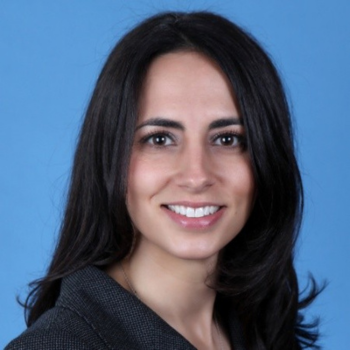
Dana Hollins
AIHA COVID-19 Re-Open America Guidelines Task Force
Ms. Dana Hollins is an epidemiologist and board-certified industrial hygienist with 16 years of professional experience in industrial hygiene, environmental and occupational epidemiology, exposure assessment, and human health risk assessment. A significant portion of her practice is dedicated to researching, measuring exposure, reconstructing dose and exposure, and assessing risks to consumers, communities, and workers exposed to a variety of chemicals. Ms. Hollins has also been involved in preparing guidance documents and health and safety plans to assist organizations in preparing and responding to the COVID-19 pandemic, including developing risk management and communication strategies and returning to normal operations plans.
Ms. Hollins is the 2020 recipient of the AIHA Kusnetz award. She currently serves on the Editorial Board for the Toxicology and Industrial Health journal. Ms. Hollins served on the AIHA COVID-19 Re-Open America Guidelines Task Force, which just recently received the 2020 AIHA Social Responsibility award, and the 2020 AIHA President’s Award and currently serves on the AIHA Back to Work Safely (BTWS) Tiger Team.
Ms. Hollins has co-authored over 60 published papers and scientific presentations and recently guest-edited a special edition for the TIH journal devoted entirely to COVID. She received her Master’s in Occupational and Environmental Epidemiology from the University of Michigan.

Jennifer Hughes, Ph.D., MPH
Associate Professor at UT Southwestern Medical Center
Jennifer L. Hughes, Ph.D., M.P.H., is an Associate Professor and Licensed Psychologist at the UT Southwestern Center for Depression Research and Clinical Care (CDRC). She is the head of the CDRC Risk and Resilience Network, which aims to build partnerships with local schools and youth community organizations to implement mental health promotion and suicide prevention programs, as well as to work together to understand resilience and risk in youth better.
Dr. Hughes is also the Operations Lead for the UT Southwestern Texas Youth Depression and Suicide Research Network, an initiative of the Texas Child Mental Health Care Consortium.
Dr. Hughes is currently on the Executive Board of the American Psychological Association Division 53 Society of Clinical Child and Adolescent Psychology (SCCAP) and served as a past Chair of the Association for Behavioral and Cognitive Therapies (ABCT) Child and Adolescent Depression Special Interest Group (SIG).

Joanne Beames, PhD
Black Dog Postdoctoral Research Fellow & Clinical Psychologist
Dr. Beames is an early-career postdoctoral research fellow at the Black Dog Institute, University of New South Wales (2019-current). She is also a 2019 UNSW Women in Maths and
Science Champion and practicing clinical psychologist registered with the Psychology Board of Australia. She received her Masters in Psychology (Clinical) and PhD at the School of Psychology UNSW in 2019 and her Bachelor of Psychology (Hons 1) at the same university in 2014.
Dr Beames has expertise in the prevention and treatment of mental health problems, including depression and anxiety in young people, the use of e-health technologies in mental health, and implementation research conducted at scale. Dr. Beames is currently investigating the implementation of evidence-based digital technology to prevent depression in young people in schools.
Her work aims to improve the reach, uptake, and effectiveness of psychological interventions in schools and improve mental health outcomes for young people.
She also received a competitive Wellcome Trust Active Ingredients Commission (2020), as part of a worldwide effort to identify the “best bet” components of psychological interventions for young people. This work identified the key role of affective awareness in preventing and early intervention of youth depression and contributes to the Trust’s ongoing international efforts to understand what works for whom.
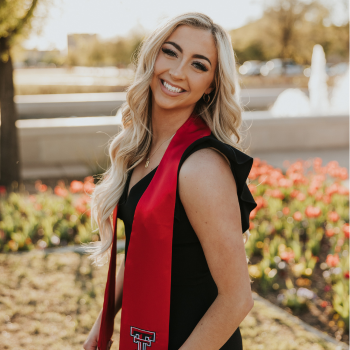
Hunter Heck
Law Student At The University Of Virginia School Of Law & Former Student Body President At Texas Tech University
Hunter Heck is a first-year law student at the University of Virginia School of Law and former student body president at Texas Tech University. In May 2021, she graduated summa cum laude with a B.A. in Philosophy and Spanish from Texas Tech University as a Highest Ranking student and with honors from the Honors College. Her other graduation honors include Honors College Student of the Year, Department of Philosophy Outstanding Senior, and Banner Bearer for the Honors College. She is also a member of Phi Beta Kappa and Phi Kappa Phi.
At Texas Tech, Hunter served as president and senator at-large for Student Government Association, president of Mortar Board National College Senior Honor Society, peer mentor for the Honors College First-Year Engagement Program, and 2019 Homecoming Queen. As an Honors College Undergraduate Research Scholar, Hunter studied feminist legal theory and analyzed the impact of gender bias on voting behavior, representation, and the electability of women to United States executive office. She was recognized as Outstanding Undergraduate Researcher at the Texas Tech University Undergraduate Research Conference 2021.
Her prior work experience includes a congressional internship for the United States Senate and legal internship for the Texas Tech University System Office of General Counsel. Following graduation from Virginia Law, Hunter hopes to pursue a career in government and public service. Her areas of interest include appellate litigation, civil rights, and constitutional law.
Jayne Morrow 00:05
Hello, everyone. Thank you so much for joining us today. We’re thrilled to welcome you to IBEC’s discussion on “Resilience, Recovery, Return: Getting Back to School Confidently and Safely.” I am Jayne Morrow, the president of IBEC and Assistant Vice President for Research and Economic Development at Montana State University. Today’s session aims to offer you the most advanced science, as well as improving guidance and better communication tools. We will focus on opportunities to translate science and knowledge across various fields to help communities reduce exposure and better manage risk. Today’s moderators, Dr. Claire Bird and Brett Cole, have worked diligently to organize this session. We’re excited to have speakers from around the world.
Claire Bird hails from the UK and has a broad-based environmental science background. She moved to Australia to establish an environmental biotechnology laboratory at Flinders University. Claire now owns an Australian-based consulting business called Litmus and has been engaged to reduce contaminant exposure risk in some of Australia’s largest remediation projects.
Brett Cole is the Managing Director and Chief Occupational Hygienist at Biosafety International. His experience spans across academic microbiological research, engineering controls, and facility microbial testing and decontamination.
Brett Cole 04:49
Thank you, Jayne, for the introductions. This event comes at a timely period, especially with the US, Britain, and Australia returning to school after lockdowns and summer breaks. It’s a great opportunity to share knowledge and answer questions regarding returning to school safely.
Claire Bird 05:52
Absolutely, Brett. We’re looking to our panel of experts today for advice, as the information people are seeking isn’t as readily available as it should be. That’s why we have Dana here to discuss the American Industrial Hygiene Association’s guidelines for reopening schools. Our panel aims to address the complexities of psychological and technological barriers to safely returning to schools.
Brett Cole 06:37
I couldn’t agree more. The human element, the built environment, and guidance documentation are all part of a holistic plan to return to school safely. Our panel today encompasses all these elements.
Let’s introduce our first panelist, Hunter Heck, a law student from the University of Virginia and former Student Body President at Texas Tech University. She has been acknowledged for her academic achievements and has served in various leadership roles. Her areas of interest include appellate litigation, civil rights, and constitutional law. Welcome, Hunter.
Hunter Heck 08:47
Hello everyone, and thank you for having me. I’m Hunter Heck, currently a student at UVA. Last year, during the 2020-2021 school year, I served as the student body president at Texas Tech University. My term began just as the pandemic hit the United States, with schools transitioning to virtual learning and no in-person gatherings. I was deeply involved in discussions about academic policies, course modality, and resources for students during that time. I aim to provide insight into how higher education administrative decisions were made in response to the COVID-19 pandemic. My experience at Texas Tech University revealed a student body that was often resistant to what they perceived as overbearing government policies, such as wearing masks and social distancing. We endeavored to foster unity and compliance among the students, achieving varying degrees of success. I’m thrilled to be here among such knowledgeable individuals and eager to learn as well as share. Thank you for this opportunity.
Brett Cole 11:12
Thank you, Hunter. It’s imperative that we incorporate the student’s perspective, as it offers a vital viewpoint for our discussions. We’re grateful to have you here. Next, we have Dr. Jennifer Hughes from the University of Texas Southwestern Medical Center. Dr. Hughes is an associate professor and licensed psychologist at the UT Southwestern center for depression research and clinical care. She leads the CDRC risk and resilience network and focuses on mental health promotion, suicide prevention, and understanding resilience and risk in youth. Dr. Hughes’s extensive experience includes roles at the Children’s Health System and UCLA. She’s also a recipient of several accolades in her field. We warmly welcome Dr. Hughes to share her insights.
Jennifer Hughes 13:34
Thank you for the warm welcome. Early in the pandemic, my team was involved in delivering mental health promotion programs to schools. The sudden shutdown of schools in early 2020 halted these crucial initiatives. Partnering with schools across Texas and the U.S., our main objective was to understand the varying perspectives of teachers, parents, and students regarding their return to schools. While there were concerns about students’ academic health, mental health was equally emphasized. With the roll-out of vaccines, some of these apprehensions shifted. From a psychology and public health viewpoint, the ever-changing information has led to decision fatigue among many. I look forward to contributing to our discussion today. Thank you.
Claire Bird 16:21
Thank you, Jennifer. The challenge of ongoing change and ensuring mental well-being is crucial. I’m eager to delve deeper into this topic. Our next speaker is Dr. Joanne Beames, a postdoctoral research fellow and clinical psychologist at the Black Dog Institute and the University of New South Wales. Dr. Beames has expertise in preventing and treating mental health issues in young people. Currently, she is focusing on the implementation of digital technology to universally prevent depression in youths within school settings. Dr. Beames emphasizes the importance of working directly with young individuals in the creation and implementation of these technologies, ensuring their needs and feedback are integral to the development process. We now invite Dr. Beames to share her thoughts.
Joanne Beames 18:03
Hello, everyone. I’m delighted to be a part of this panel. The Black Dog Institute is a medical research organization in Sydney, Australia, dedicated to delivering impactful research related to mental health. One of our primary focuses is on young people and school-based programs. Navigating the challenges brought about by COVID-19, we have sought to understand and address various factors, from the immediate impact on mental health to the after-effects of other community-wide disasters, like bushfires. Our aim is to be proactive in crafting psychological disaster response plans. In collaboration with schools, we have been actively working to develop and implement mental health programs tailored to the unique challenges young people face today. One key recommendation is to invest significantly in areas with the most substantial potential impact. Another is to co-create digital mental health solutions with young people. Thank you for having me.
Claire Bird 22:06
Thank you, Joe. A quick question: in your bio, you mentioned “effect components of psychological interventions.” Could you elaborate on that?
Joanne Beames 22:15
Certainly, Claire. Psychological interventions are typically multi-faceted, addressing various processes related to mental health. The Wellcome Trust initiative sought to deconstruct these interventions to identify which specific components were most effective in promoting positive outcomes. Research might focus on areas such as problem-solving, sleep, or understanding emotions. Additionally, we consider both psychological and underlying biological processes.
Claire Bird 22:58
Thank you, Dr. Beames. Let’s move on to our next panelist, Bryon Price. Bryon offers a blend of technological and practical expertise. He’s a seasoned professional engineer in building services and serves as the Strategic Development Director for the Ag Coombs Group of Companies. Bryon also chairs the board of the Facility Management Association of Australia and holds various other prestigious positions in the field. Notably, he co-chairs the International Well Building Institute taskforce on COVID-19 and other respiratory infections. Over to you, Bryon.
Bryon Price 23:57
Thank you, Claire. The emergence of the Delta variant, coupled with an enhanced understanding of aerosol transmission, has underscored the significance of ventilation. Two primary points I’d like to stress today are: first, managing expectations surrounding ventilation—it’s not a magic solution, but proper ventilation can certainly decrease the likelihood of aerosol transmission. Secondly, it’s imperative to comprehend the mechanism of aerosol transmission to appreciate how ventilation can mitigate its spread. By understanding these principles, we can better tailor our approaches to various settings. While mechanical ventilation uses technology to regulate airflow, non-mechanical ventilation relies on natural means like open windows. Modifying ventilation can be challenging, especially when intertwined with heating and cooling systems. It’s essential to consider each unique setting, relying on available guidance and experts in the field, to optimize outcomes. In summary, understanding the basic principles of aerosol transmission and ventilation is crucial. From there, we can effectively tailor solutions to specific environments.
Brett Cole 29:52
Thanks, Bryon. Your insights on the challenges of balancing ventilation with external factors are invaluable. This discussion sets the stage perfectly for our next speaker, Kate Cole. Kate will delve into the crucial role masks and PPE play in containing the spread of the virus, building upon Bryon’s points about ventilation. Kate is a leading figure in occupational hygiene, serving as the Managing Director of Cole Health and the President-Elect of the Australian Institute of Occupational Hygienists. A Winston Churchill Fellow, she’s been recognized as a significant influencer in her field. Kate’s commitment during the COVID-19 pandemic, particularly in areas like ventilation, respiratory protection, and general health and safety, is commendable. She has also been instrumental in removing counterfeit masks from the Australian market. We’re eager to hear from Kate about her insights on these matters.
Kate Cole 32:31
Thank you for the invitation. Firstly, I’d like to acknowledge the Gadigal people, the traditional custodians of the land I’m speaking from today, and pay my respects to their elders, past and present. For those unfamiliar, I’m currently based in Sydney, Australia, which is on Gadigal land and is under lockdown. I am an occupational hygienist, and our profession focuses on protecting worker health from a variety of hazards. Within the scope of COVID-19, we draw upon expertise in infection control, epidemiology, aerosol physics, ventilation, and protective equipment, among other areas. We employ the hierarchy of controls to safeguard health, knowing that a multi-layered approach is often the best defense. In the context of classrooms, attention needs to be centered on two main areas: ventilation and masks. As already emphasized, no single measure is a complete solution, so complementary interventions are essential. Ventilation is critical during the pandemic since the virus is airborne. As a member of the Australian expert network Osage, we’ve emphasized the importance of indoor air quality and suggested using carbon dioxide as a surrogate indicator to gauge indoor infection risks. In Australia, we’ve been helping schools prioritize areas needing improvement. This includes increasing outdoor air supply, reducing air recirculation, and introducing HEPA filters. At the other end of the hierarchy, we have PPE. A common misconception is that its placement at the bottom indicates ineffectiveness, which is far from the truth. Masks, when used correctly, can significantly reduce transmission risks. The challenge is ensuring good fit and filtration. In high-risk environments, we advocate for advanced respiratory protection. However, in community settings, the focus is on well-fitting masks. By adopting a range of measures, we can ensure a safer return to schools. Thank you for having me.
Claire Bird 37:30
Thank you, Kate. It’s clear that multi-faceted risk assessment is vital in managing infection spread. Duration of exposure in any given space also plays a pivotal role. A recent paper highlighted the substantial impact of masks in reducing transmission. As you mentioned, despite masks being at the base of the control hierarchy, they are paramount in our preventive measures. Your insights are invaluable. Our next panelist is Dana Hollins. She represents Cardno ChemRisk and was instrumental in shaping the American Industrial Hygiene Association’s guidelines on safely returning to school.
Dana Hollins 40:25
Thank you for the warm introduction. I’ll be sharing some slides to aid our discussion. Can everyone see them? Perfect. I’m honored to discuss AIHA’s journey with the Back to Work Safely task force and share our insights. For those unfamiliar with AIHA, it’s one of the largest global organizations of health and safety professionals. As industrial hygienists, our primary goal is to prevent workplace injuries and illnesses. In response to the pandemic, AIHA mobilized a task force of expert volunteers to develop guidelines. Our goal was to create user-friendly, science-backed resources for small and medium-sized entities. We specifically targeted smaller educational institutions, as they may lack access to health and safety professionals. We aimed for clarity, practicality, and broad relevance. Our guidance covers standard topics like hygiene, ventilation, masking, and distancing. We also addressed unique challenges, such as constantly changing guidance and ensuring our guidelines remain pertinent across various jurisdictions. It’s critical to prioritize resources and remain adaptive. We now are re-evaluating our documents, keeping them up-to-date, and considering their long-term utility and global applicability. Finally, I’d like to acknowledge my fellow task force members. Their collaborative spirit was invaluable in this effort. I’m eager for our continued conversation.
Brett Cole 46:15
Thank you, Dana, and to all our panelists for the insightful introductions. Balancing information, misinformation, health considerations, building safety, PPE, and more has been a monumental challenge, not only for industry insiders but also for the general public. I often mention that this pandemic made us momentarily forget everything we’ve known, and many have underscored that point. Although some of these protocols are standard in hospitals and industrial environments, they’re novel to the general community. The silver lining is the potential learning and knowledge-sharing opportunity it presents. I’d now like to move us to an open forum. For our attendees, please feel free to ask questions via the chat function. To kick off the forum, I pose this question to our panelists: How much do you think feeling safe and confident contributes to people’s willingness to return to work or school? Perhaps we can start with Jennifer or Bryon.
Bryon Price 48:06
Observing people’s reactions and sentiments towards the pandemic has been intriguing. In Australia, the response has varied across states based on individual experiences. States like Victoria, which have faced multiple lockdowns, show a hesitancy to return to normal activities. Meanwhile, other states with fewer cases show a quicker return to normalcy. People’s feelings of safety seem deeply tied to personal experiences and general sentiment, making it a complex factor to quantify.
Kate Cole 49:14
Safety goes beyond just physical measures. People need to genuinely feel safe, and for that, scientifically backed and effective interventions are paramount. Psychological safety is intertwined with physical safety. The debate around mask-wearing is a classic example. To ensure true safety, both physical and psychological, a robust approach that encompasses various measures, from ventilation to protective equipment, is essential.
Brett Cole 50:33
Thank you, Bryon and Kate. Clearly, a holistic approach to safety, one that addresses both physical and psychological dimensions, is crucial. Now, turning to Joanne and Hunter, I’d like to understand from a young adult’s perspective, and representing other students, what are the primary challenges they face during the pandemic, aside from the obvious risk of infection?
Joanne Beames 50:45
Absolutely, feeling safe is paramount. While I concur with Kate and Bryon’s viewpoints, I’d like to add another dimension. We’ve observed that fear and anxiety, pervasive emotions during this pandemic, substantially influence our behaviors. If dominated by these feelings, we tend to avoid engaging with the external world and retreat into our shells. This holds especially true for young individuals who might be anxious about going back to school or even something as simple as wearing a mask. Such fears can be major obstacles, necessitating collective efforts to mitigate them. Addressing the prevalent uncertainties, whether it’s about contamination, mask efficacy, or even broader concerns about the future, becomes vital. Thus, a combination of feeling safe, valued, and understood is essential for the youth and staff to reengage in their respective communities.
Brett Cole 51:56
Thank you, Joanne. It’s evident that the emotional and psychological facets play a pivotal role in one’s sense of safety and their willingness to reintegrate into schools and workplaces. Let’s pivot a bit. Given our current understanding and sentiments about COVID-19, I’m curious, Jennifer, about your insights. With communities expressing reluctance to return to schools and workplaces after extended periods of remote work and study, what do you believe fuels this hesitancy?
Jennifer Hughes 52:35
There’s a confluence of factors at play. An insightful paper in The Lancet Regional Health – America by Dr. Levinson provides a health policy perspective on this hesitancy. A portion of this reluctance stems from genuine health concerns, especially in places like the U.S., where community transmission rates varied widely. Individuals and families grapple with a nuanced risk-benefit analysis, considering factors such as vulnerable family members and vaccination status. There’s an extensive body of research on vaccine hesitancy that suggests the importance of understanding and addressing people’s psychological states. On top of individual and community factors, in the U.S., there’s the added complexity of policy mistrust. Many traditionally reliable health information sources have become embroiled in political controversies, leading to a trust deficit. States and local communities are crafting their policies, sometimes aligned with national guidance and sometimes not. Taking Texas as an example, the emphasis on autonomy and individual freedoms has at times conflicted with recommended safety measures. In fact, some parents are even suing school districts, alleging insufficient safety protocols. In essence, the hesitancy is a blend of individual, community, and political factors, further complicated by conflicting information and guidelines.
Brett Cole 55:15
I appreciate the depth of your response, Jennifer. A question from our forum that I’d like to explore further pertains to the potential psychological impacts of mask-wearing for students. Is it suitable for all age groups, including primary, secondary, and tertiary students?
Jennifer Hughes 55:39
Parents often voice these concerns. While more research is needed, particularly from a developmental standpoint, it’s worth noting the importance of facial cues in our emotional and social interactions. Wearing a mask undeniably alters these interactions, which might have developmental repercussions over time. However, we use multiple cues in communication. When weighing the pros and cons, the known benefits of wearing masks, both for individual protection and community safety, and the advantages of in-person learning and social interaction, must be considered. Even with masks, students gain valuable experiences in classrooms. And it’s noteworthy that students, accustomed to school structures and rules, often adapt quickly to mask policies. Here, even children as young as three have been seen to wear masks without much fuss, given the structured nature of educational settings.
Brett Cole 57:50
Thank you for the insight, Jennifer. It’ll indeed be intriguing to observe the long-term studies on this. Hunter, reflecting on your personal experience and representing other students, could you highlight the most pressing issues the youth face during this pandemic, beyond the direct threat of the virus?
Hunter Heck 58:18
Certainly. It’s crucial to recognize the challenges the past year and a half has presented for students, families, and all involved, given the substantial shifts in life as we knew it. For students, it felt as though the very community they cherished and relied on was abruptly taken away. Integral elements of the student experience, even simple joys like Saturday football games, were suddenly inaccessible. These losses, coupled with the lack of vital components of student well-being, adversely impacted many students’ mental health. During my term, we had frequent discussions with students grappling with the effects of isolation and quarantine. Transitioning to online learning also posed challenges. The shift from physically attending classes and directly interacting with professors to merely logging into Zoom was drastic. I’ll admit, there were times I attended class right from my bed. These dramatic alterations added layers of complexity to an already difficult year. However, amid these challenges, I was heartened to see the sense of solidarity among students and their mutual concern for each other’s well-being. That said, there were those resistant to protocols. On-campus behavior concerning guidelines like mask-wearing often didn’t reflect off-campus behavior. The majority of COVID transmissions we observed occurred off-campus. This disparity was challenging to address from a university student government standpoint. Three prominent challenges emerged: the altered academic experience, mental health implications, and the battle against misinformation. With social media amplifying misinformation, many students remained misinformed about masks’ primary purpose, that they protect not just the wearer but others around them. Addressing this misinformation, I believe, will remain a crucial task moving forward.
Brett Cole 1:02:05
Hunter, thank you for offering such a comprehensive perspective. Your insights are invaluable.
Claire Bird 1:02:09
Indeed. It’s heartening to hear about instances of collaboration and mutual concern. Emphasizing our responsibility to safeguard others, not merely ourselves, could be a turning point. Recognizing and embedding this mindset could be a powerful paradigm shift. I have a question for Kate now. Kate, given recent discussions, can you elucidate from an Occupational Hygiene viewpoint about the safety of masks, particularly concerning potential respiratory inhalation risks for children and teachers?
Kate Cole 1:03:00
It’s vital to distinguish between masks and respirators. High-grade respiratory protection, like N95 or P2 respirators, mandates a respiratory protection program, which includes a prior medical assessment. This rigorous procedure ensures the respirator’s fit and filtration are appropriate for the wearer. Contrarily, masks, while they may fit well, do not have the same tight fit or high filtration levels as respirators. Although certain medical conditions might prevent some individuals from wearing masks, the vast majority can wear them without any health concerns. The key is to identify the most suitable mask. Involving children in this decision, similar to how we involve them in selecting comfortable shoes, is beneficial. Not all masks are created equal. Just as my three children prefer different masks, it’s essential to consider individual comfort. In summary, the rigorous safety measures applied to high-grade respirators shouldn’t be conflated with the standard safety precautions for masks. If ever in doubt, individuals should consult their medical professionals.
Claire Bird 1:05:25
So, Kate, in an environment where a teacher is surrounded by masked children, would a regular mask suffice? Or would you recommend a fit-tested respirator?
Kate Cole 1:05:37
High-grade respirators, like N95 or P2, are advisable in settings with confirmed or suspected COVID-19 cases, like quarantine hotels or healthcare environments. Schools, where symptomatic individuals shouldn’t be present, represent a different risk environment. There, a well-fitted surgical mask or a general face mask is recommended. However, it’s crucial to note that while schools are primarily populated by teachers and students, they also have staff like school nurses who might occasionally encounter symptomatic individuals. In such scenarios, respiratory protection is recommended. In cases where respiratory protection is necessary, fit-testing and adherence to a respiratory protection program are crucial.
Claire Bird 1:07:56
Thank you, Kate. Your clarification on this matter is immensely helpful. Now, Bryon, focusing on building service providers and facility managers, what would you identify as the major challenges they face concerning educational and workplace environments?
Bryon Price 1:08:16
One overarching challenge, Claire, is enhancing industry awareness. The significance of aerosol transmission and ventilation’s role in mitigating its effects has only recently been acknowledged. While some early adopters raised alarms nearly 18 months ago, official communications from government and health organizations were often ambiguous or even contradictory. Even now, the terminology used—like “fomite transmission” or “incidental contact”—fails to elucidate aerosol transmission’s role and the importance of ventilation. Many school settings, particularly primary and high schools, have not traditionally emphasized specialized ventilation systems. This lack of expertise presents a challenge. Furthermore, while COVID-19 has spotlighted the role of ventilation in schools, concerns about the relationship between CO2 levels, ventilation rates, and their impact on learning and health have been growing over the past decade. Addressing these needs requires a significant industry recalibration. Another complicating factor is the regulatory framework surrounding ventilation. Much of the regulation focuses on the design and construction phase, neglecting existing buildings. In environments where stricter ventilation standards are imposed due to connections with fire management systems, service providers have a clearer framework to follow. But in more standard settings, there’s a lack of clarity. Enhancing industry awareness, providing clear messaging, and developing a solid educational foundation are paramount challenges.
Claire Bird 1:11:45
You touched on the concept of “step changes”. One of the questions we have planned for later, which others might wish to answer as well, concerns the role of professional bodies and associations in assisting individuals with these step changes. Moreover, Dana, since you’ve been actively involved in producing guidance documents, how can we ensure consistency in these guidelines and offer support to our members for this transition?
Bryon Price 1:12:16
That’s an insightful question. When I consider change and its management, I reflect on our industry’s response to similar past changes, be it building energy efficiency or other societal concerns. While we reside in the information age, access to information is not the primary issue. We need reliable guidance, particularly for those who are non-experts in this novel area. They seek authoritative backing for the information. Traditionally, government support has been the primary source for credible information, which is presently lacking. In Australia, each state and territory determines the quality of infrastructure in schools. Existing guidance outlines how these should be designed, constructed, and operated, but there’s a noticeable void concerning ventilation’s role in the current scenario. For rapid progress, we need government-approved guidance. It’s not solely about creating guidelines; we must effectively promote them. Reliable government-sanctioned guidance is an urgent step in managing change. In today’s digital age, the challenge isn’t misinformation or a lack of information, but rather discerning which information to trust and act upon.
Claire Bird 1:15:15
Thank you, Bryon, for that perspective. Dana, as someone involved in formulating guidance documents, how do you ensure the inclusion of the right stakeholders? Additionally, what obstacles have you encountered in promoting the adoption of these guidelines?
Dana Hollins 1:15:33
Hindsight, they say, is 20/20. These crises always offer lessons. Now, we understand the importance of proper planning and the need for multidisciplinary teams, comprising industrial hygienists, medical professionals, biosafety experts, and HVAC engineers. The pandemic has amplified the role of industrial hygienists. Collaboratively, these experts can design, implement, and amend infection control measures in buildings. Organizations like AIHA, ACGIH, and IOH play pivotal roles in equipping their members with tools, documents, and training for informed risk management decisions. Additionally, producing guidance documents for a wider, non-expert audience, especially underserved communities, became a priority. However, producing these documents is only half the battle; effective publicity is crucial. In 2020, we recorded 1.5 million downloads of our guidance documents, a number that rose to 3 million in the following eight months. This indicates a sustained demand for authoritative guidance on navigating the pandemic.
Joanne Beames 1:18:11
I concur. While AIHA’s guidance has been instrumental internationally, our approach in Australia has slightly differed. We’ve engaged with existing stakeholders to improve guidance. For instance, during Victoria’s second wave, which impacted over 4,000 healthcare workers, our task forces worked alongside the Department of Health to enhance guidance on respiratory protection. We collaborated on various fronts, recognizing the value each stakeholder brings. Our aim has always been to provide practical solutions, considering every stakeholder’s concerns and priorities.
Claire Bird 1:19:48
Thank you for that comprehensive overview. I’d now like to bring Hunter, Joe, and Jenny to the stage. Given today’s discussions, what advice would you offer school leaders about safely and confidently reopening schools?
Kate Cole 1:20:22
CO2 monitors with a traffic light system can be incredibly useful. They offer a predictive model to assess risk and take appropriate action. A best practice recommendation is 600 ppm, above which action should be taken to increase ventilation. These monitors don’t dictate what’s safe or unsafe; rather, they indicate lower or higher risk scenarios, prompting us to take necessary actions to mitigate those risks.
Claire Bird 1:21:59
Given today’s discussions, what advice would you offer to school leaders about returning to school safely?
Joanne Beames 1:22:20
Clear communication about risk and safety measures can alleviate uncertainties and provide reassurance. Masks are a prime example where clear information can make a big difference in compliance and effectiveness.
Hunter Heck 1:23:07
From a student perspective, empathy and patience are crucial as we navigate this return to normalcy. Everyone’s comfort level differs, so it’s essential to take an educated, community-oriented approach. Depending on the community, vaccination rates may vary, so localized strategies can be effective. However, above all, we should remember the challenges everyone has faced over the past year and a half and be patient with one another. We must continue focusing on health and safety while being amazed at the resilience our communities have shown.
Jennifer Hughes 1:25:34
Thank you, Hunter. It’s essential to practice grace with each other, given the prolonged stress everyone has experienced. As school leaders navigate the return to classrooms, it’s crucial to realize that while many, especially children, are resilient, we should also remain vigilant for those who might be struggling more than others. This goes for students, staff, and the community. Schools should establish programs to identify students who might be undergoing trauma related to the pandemic. The unfortunate loss of many lives means a significant number of students may be grieving for family members or friends. Schools should look out for behavioral changes, mood shifts, or increased irritability as signs of profound distress. Addressing the social and emotional learning and mental health needs of students is vital, especially since some might have missed out on these during remote learning. I appreciate the Black Dog Institute’s work on digitally delivering such resources, as it has become crucial during these transitions. It’s equally essential to ensure our school staff and employees receive the support they need, considering the challenges they face personally and professionally.
Claire Bird 1:28:34
Thank you for your insights, Jennifer. Unfortunately, our time is up. I’d like to extend a heartfelt thank you to everyone for such an enlightening session. Thanks also go out to the IBEC team and Brent for their unwavering support.
Jayne Morrow 1:29:07
Claire, Brett, and all our esteemed speakers, a heartfelt thank you. It’s heartening to see professionals dedicated to public health and safety working tirelessly across the globe. To our Australian friends, we’re glad you’re safe post-earthquake. Today’s discussions have underscored IBEC’s mission. We delved into the constantly evolving nature of science, response strategies, and the real decision fatigue many face. Dilution, density, distance, and duration remain central to our interaction within built spaces. But it’s not just about tools; the human aspect is paramount. A sincere thank you to those who highlighted this. At IBEC, our focus remains on people, buildings, and pathogens, ensuring all these domains converge seamlessly. The call for empathy, education, and community-focused responses resonated deeply. Let’s aim for resilience, tolerance, and kindness, ensuring health and safety remain our priority. Thank you all for your time, and we look forward to further enlightening discussions. Stay safe and take care.
Sponsor Spotlight
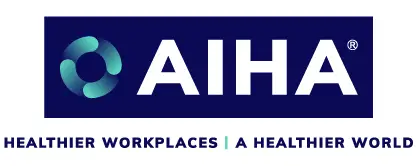
American Industrial Hygiene Association (AIHA)
AIHA is the association for scientists and professionals committed to preserving and ensuring occupational and environmental health and safety (OEHS) in the workplace and community. Founded in 1939, we support our members with our expertise, networks, comprehensive education programs, and other products and services that help them maintain the highest professional and competency standards. More than half of AIHA’s nearly 8,500 members are Certified Industrial Hygienists, and many hold other professional designations. AIHA serves as a resource for those employed across the public and private sectors and the communities in which they work.
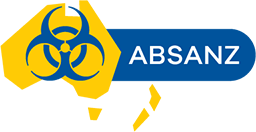
Association of Biosafety For Australia and New Zealand (ABSANZ)
ABSANZ – the Association of Biosafety for Australia and New Zealand – was formed to share knowledge about biosafety and biosecurity in an open, collaborative, and informative way. Its purpose is to protect people, the community and the environment through advancing knowledge in biosafety and biorisk management.

IEQ Global Alliance(AIHA)
The mission of IEQ-GA is to provide an acceptable indoor environmental quality (Thermal environment, sound, light and indoor air quality) to occupants in buildings and places of work around the world and to make sure the knowledge from research on IEQ gets to be implemented in practice.
Have a question about the event?
Connect with IBEC experts directly! Drop your queries below, and let's further the dialogue on preventing the spread of infectious diseases.

